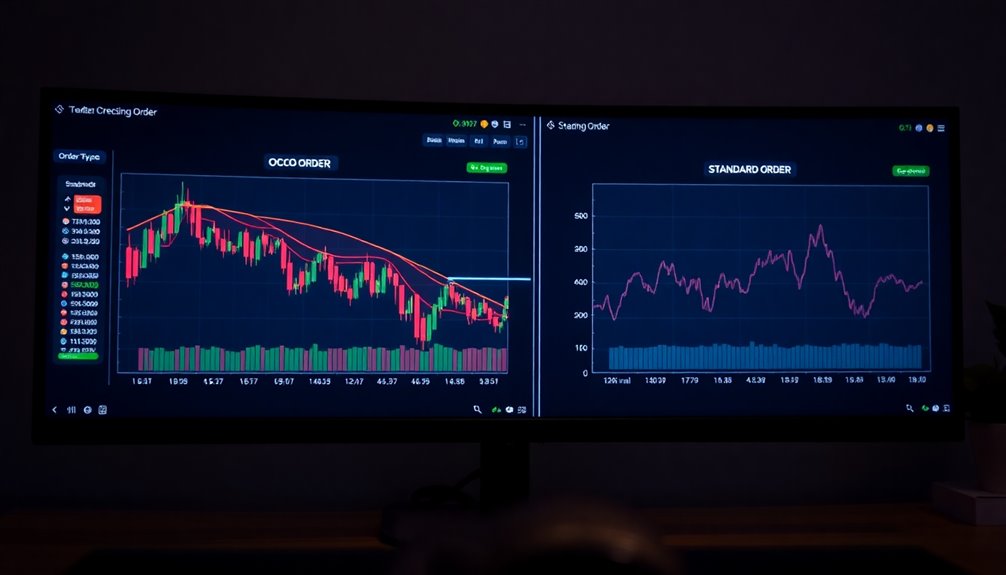An OCO order, or "One Cancels Other," is a smart trading tool that merges a limit order with a stop order. This setup lets you effectively manage your risks while automating your strategy. When you set an OCO order, if one order executes—say your limit order—the other order (the stop order) automatically cancels itself. This is great for capturing profits or minimizing losses without the need to watch the market constantly. Understanding how to set it up can further enhance your trading efficiency and success. You'll find more details on maximizing its potential for your trading strategy.
Key Takeaways
- OCO stands for "One Cancels Other," combining a limit order and a stop order for effective trading management.
- It allows traders to set stop-loss and take-profit levels simultaneously, automating risk management.
- One order automatically cancels when the other executes, preventing conflicting positions in trades.
- OCO orders are beneficial in managing risks, particularly in volatile markets, while enhancing trading efficiency.
- Not all brokers support OCO orders, and their complexity may challenge new traders.
Order Type Overview

When you're trading, understanding the different types of OCO (One Cancels Other) orders can significantly enhance your strategy.
You've got several options tailored to different scenarios. The stop-loss/take-profit OCO order helps you manage risk by setting both a stop-loss below and a take-profit above the current price. This type of order is particularly beneficial for enhancing risk management in volatile markets.
An entry order/stop-loss OCO order combines a limit entry with a safety stop-loss.
If you anticipate a breakout, the breakout OCO order places buy and sell orders around key support and resistance levels.
Lastly, the hedging OCO order allows you to protect your positions by placing a market buy alongside a predetermined sell.
Knowing these types can give you an edge in executing your trades effectively.
Understanding OCO Orders

Understanding OCO orders is crucial for any trader looking to streamline their trading strategy and manage risk effectively.
These orders allow you to set two simultaneous orders, helping you protect against losses while securing profits. By automating the trading process, OCO orders save you time and reduce the risk of human error, ensuring your decisions aren't swayed by emotions. They provide precision, enabling you to enter or exit trades at specific price levels aligned with your strategy. Though setting them up may seem complex, their benefits in trade management and risk mitigation make them invaluable. Moreover, OCO orders are particularly beneficial in volatile markets, where price fluctuations can occur rapidly.
Just remember, once placed, these orders can't be modified without cancellation, so plan carefully to avoid missed opportunities.
Execution of Conditional Trades

OCO orders enable you to execute conditional trades effectively, allowing you to capitalize on market movements while managing risk.
These orders often combine a stop order and a limit order, creating strategies like stop-loss/take-profit setups. For instance, you can link a stop-loss order below the current price and a take-profit order above it.
When one order executes, the other automatically cancels, eliminating conflicting positions and ensuring agility in your trading. This is especially useful in volatile markets where you want to capture breakouts or manage risk effectively. Additionally, OCO orders serve as a comprehensive risk management tool, allowing traders to set predefined exit strategies that mitigate potential losses and secure gains.
Pros and Cons Summary

The use of OCO orders offers a blend of advantages and drawbacks that every trader should consider.
On the plus side, OCO orders help you mitigate risk by automatically canceling one order when the other executes, streamlining trade management and saving time. They provide flexibility for various strategies, allowing you to set orders at different price levels. This is particularly beneficial in trading volatile stocks with wide price ranges.
However, setting up OCO orders can be complex, especially for beginners. You might face limitations based on your trading platform, and technical issues could impact execution.
Additionally, if one order partially fills, the remaining orders may not cancel immediately, leading to potential overfills.
Weighing these pros and cons will help you decide if OCO orders fit your trading style.
OCO vs. Standard Orders

When managing trades, knowing the differences between OCO orders and standard orders can significantly impact your strategy.
OCO orders combine a stop and a limit order, ensuring that executing one cancels the other. This feature allows for efficient risk management, as you can set both stop-loss and take-profit levels in one go. Additionally, understanding advanced stock orders is crucial to avoid costly errors in your trading.
In contrast, standard orders operate independently, requiring manual adjustments and posing a higher risk of mistakes. They're simpler, making them great for beginners, but lack the conditional execution aspect of OCO orders.
If you're looking for precision and automation in your trading, OCO orders might be more beneficial. However, if you prefer simplicity and flexibility, standard orders could suit your needs better.
Market Volatility Impact

Market volatility can significantly influence your trading outcomes, especially if you're using OCO orders. In fast-moving markets, you may find that your orders don't execute as quickly as you'd hoped, leading to missed opportunities. Limited liquidity can further hinder swift execution, causing delays that impact your strategy. Rapid price movements often result in orders not filling at your desired levels, increasing the risk of slippage. However, OCO orders can help manage this risk by setting both a profit target and a stop-loss level, protecting you from excessive losses. They automatically cancel the other order, ensuring you only take one action, which is crucial during volatile market conditions driven by news or events. Furthermore, OCO orders provide automated monitoring, which reduces the need for constant screen time and allows traders to focus on market analysis.
Algorithmic Trading Innovations

As trading evolves, algorithmic innovations are reshaping how you engage with financial markets.
With AI and machine learning, you can leverage predictive analytics for real-time decision-making, enhancing your trading strategies. Quantum computing offers unparalleled speed, processing vast amounts of data more accurately than ever before.
Big data analytics help you extract deep market insights, adapting to ever-changing conditions. Trading strategies like statistical arbitrage and market making thrive on these technologies, allowing you to identify pricing inefficiencies and adjust orders swiftly. Additionally, algorithmic trading now accounts for a large portion of overall trading volume, reflecting its growing significance in the financial landscape.
Plus, sentiment analysis tools gauge market moods using news and social media. Overall, these innovations provide you with reduced latency, lower transaction costs, and minimized manual errors, creating a more efficient trading experience.
Set Clear Profit Targets

Setting clear profit targets is essential for successful trading, especially in volatile markets where price movements can be unpredictable. With OCO orders, you can combine a limit order and a stop order, allowing you to secure gains while managing risks. To set your profit target, determine a limit order price above the current market value that aligns with your trading strategy. For example, if you buy a stock at $100, consider setting a limit order at $110 and a stop-loss at $90. This method automates your trading process, ensuring that one order cancels the other upon execution. By using OCO orders, you can reduce emotional decision-making during trades, providing a more structured approach to your trading strategy.
Frequently Asked Questions
Can OCO Orders Be Used for All Types of Assets?
Yes, you can use OCO orders for various asset types, including stocks, forex, futures, and even options.
They allow you to set both profit targets and stop-loss levels simultaneously, making them versatile for different trading strategies.
Whether you're aiming to capture market movements or manage risk, OCO orders can help streamline your trading process across multiple platforms.
Just remember, they're particularly beneficial in volatile markets where prices fluctuate significantly.
How Does an OCO Order Affect Trading Commissions?
An OCO order can significantly affect your trading commissions. Since these orders involve conditional aspects, platforms may charge higher fees compared to traditional orders.
If your order experiences partial fills, you'll only pay commissions on the executed portions, potentially leading to multiple transaction fees.
Additionally, rapid market changes and liquidity issues can impact execution speed and costs, making it essential to understand your platform's fee structure when using OCO orders.
Are OCO Orders Available on All Trading Platforms?
OCO orders aren't available on every trading platform, which can be frustrating for some traders.
While advanced platforms like Thinkorswim and certain Forex brokers offer this feature, many major platforms don't support it.
This discrepancy can impact your trading strategy, especially if you thrive in volatile markets.
If you're an active trader, finding a platform that supports OCO orders is crucial for managing your trades effectively and efficiently.
What Happens if Both Conditions of an OCO Order Are Met?
If both conditions of an OCO order are met, one order gets executed while the other is automatically canceled.
This design ensures you won't end up with unintended positions. The trading platform is programmed to trigger only the first order, so you won't face simultaneous execution.
This mechanism protects you from unwanted trades and helps you manage risk effectively in volatile market situations.
You'll find this feature essential for strategic trading decisions.
Can I Modify an OCO Order After Placing It?
Think of your OCO order as a dynamic dance partner, each step carefully choreographed.
Yes, you can modify an OCO order after placing it, but you need to follow specific rules. Changes to both the limit price and stop-loss trigger must be made together, ensuring they still align with your strategy.
Just remember, some trading sessions might restrict modifications, so keep an eye on the platform's guidelines to avoid any missteps.
Conclusion
In the fast-paced world of trading, mastering OCO orders can feel like wielding a superhero's power. You're not just placing trades; you're orchestrating a symphony of profits and losses, dancing with market volatility like a pro. By setting clear profit targets, you're laying down a golden path to success, avoiding the pitfalls of chaos. So, embrace the OCO order and watch as your trading strategy transforms into an unstoppable force, conquering the financial realm!









